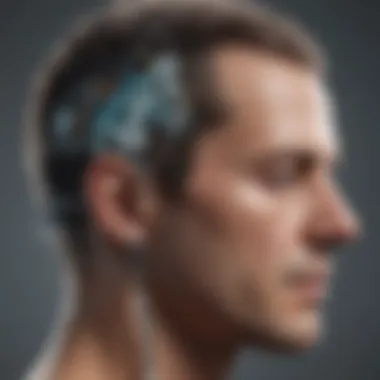Cefaly Migraine Machine: A Comprehensive Review


Intro
Migraines affect millions of individuals worldwide. They significantly impact quality of life. Traditional treatments often include medications that may not be effective for everyone. Enter the Cefaly device, an innovative approach for migraine relief. This article delves into the scientific basis of the device, its effectiveness, and the experiences of those who have tried it.
Research Background
Overview of the Scientific Problem Addressed
Migraine headaches can be debilitating. They are not just headaches; they often involve nausea, sensitivity to light, and severe pain. Researchers have consistently sought effective methods to alleviate these symptoms. The Cefaly device offers a different approach through neurostimulation. It aims to target the trigeminal nerve, a key player in the migraine pathway.
Historical Context and Previous Studies
The Cefaly device has its roots in a growing body of research exploring non-invasive treatments for migraines. Initially, studies focused on pharmaceutical interventions. Over time, researchers recognized the limitations of these solutions. In 2006, the first clinical trial assessing the efficacy of transcutaneous electrical nerve stimulation (TENS) for migraine management took place, leading to further exploration. This culminated in the development of the Cefaly device, which gained FDA clearance in 2014.
Findings and Discussion
Key Results of the Research
Multiple studies indicate that the Cefaly device can reduce the frequency and intensity of migraines. A notable trial published in The Journal of Headache and Pain reported a significant decrease in migraine days among users. Participants noted that long-term use led to cumulative benefits.
Interpretation of the Findings
The key takeaway from the research is this: the Cefaly device holds promise not only for acute relief but for preventive action too. Many users experienced fewer migraines over time. This aligns with the notion that consistent neurostimulation may enhance the brain's adaptability to pain signals.
"The Cefaly device represents a shift in how we think about migraine management, moving towards more personalized and non-pharmaceutical options."
The implications of these findings are profound. They suggest that integrating technologies like Cefaly can complement traditional treatments. However, more extensive studies are necessary to fully understand its long-term effects and optimal usage.
Information regarding further studies can be found on Wikipedia and Britannica.
Insights and personal experiences from individuals regarding the Cefaly device can also be viewed on Reddit where users share their stories.
For additional resources and community discussions, you might visit the Cefaly Facebook page.
This comprehensive exploration provides not just insights but a foundation for understanding the potential impact of the Cefaly device on migraine management.
Intro to the Cefaly Migraine Machine
The Cefaly Migraine Machine represents a significant advancement in the non-pharmacological treatment of migraines. For individuals suffering from this debilitating condition, traditional treatments often come with substantial side effects or limited effectiveness. The introduction of devices like Cefaly serves as a promising alternative, making it essential to examine their role in migraine management. This section highlights various aspects of the Cefaly device, including its theoretical foundation, practical applications, and the overall significance it holds for patients and healthcare professionals alike.
Overview of Migraine Disorders
Migraine disorders affect millions globally and present a range of symptoms that can severely impact daily life. Characterized by recurring headaches, these episodes can be accompanied by nausea, vomiting, or hypersensitivity to light and sound. The World Health Organization views migraines as one of the most disabling conditions, often leading to significant loss in productivity. Understanding migraine disorders is crucial, as it allows for more effective treatment strategies.
Research shows that migraines are typically classified into two main types:
- Migraine with aura: This type involves neurological symptoms that precede the headache.
- Migraine without aura: This more common type occurs without these preceding symptoms.
Diverse factors can trigger migraines, commonly including stress, hormonal changes, and dietary influences. The complexity of this disorder adds to the difficulty of establishing comprehensive treatment modalities, underlining the relevance of exploring alternatives like the Cefaly device.
History of Migraine Treatment Approaches
The journey of migraine treatment has evolved significantly over the years, transitioning from rudimentary remedies to sophisticated devices such as Cefaly. Historically, individuals utilized herbal treatments and intuitive strategies to manage their symptoms. As medical science advanced, the introduction of pharmacological solutions became prevalent, aimed at both preventive and acute treatment of migraines.
Key developments in migraine treatment include:
- Ergotamine in the 1920s: One of the first specific medicines for migraine relief.
- Triptans in the 1990s: These became a breakthrough with their targeted action on migraine physiology.
- Neurostimulation in the 21st century: Devices like Cefaly represent this innovative era, focusing on non-invasive methods to mitigate migraine symptoms.


The growing awareness of the adverse effects associated with traditional medications has underscored the need for safe, effective alternatives. In this context, the Cefaly device emerges as a non-invasive option that could transform how migraines are experienced and managed, thus warranting further investigation.
Understanding Cefaly Therapy
Understanding Cefaly Therapy is crucial for grasping how this innovative device addresses migraine symptoms. This section elucidates the principles behind the technology and its effectiveness. By examining the underlying mechanism of action, as well as the device's technical specifications, a clearer picture emerges of how Cefaly fits into the complex landscape of migraine management.
Principle of Transcutaneous Electrical Nerve Stimulation
Cefaly employs a technique known as transcutaneous electrical nerve stimulation, or TENS. This method involves delivering mild electrical impulses through the skin. These impulses stimulate the peripheral nerves, which then modulate the pain signaling pathways. The goal is to inhibit the transmission of pain signals to the brain. This therapy is particularly noteworthy because it operates without the use of pharmaceuticals, making it an appealing option for many patients seeking alternatives to traditional medication.
Research indicates that TENS can alter the perception of pain. It activates the body's natural analgesic systems. This means that the brain can be effectively conditioned to reduce sensitivity to further pain triggers. It is a non-invasive approach that can be used regularly without the risk of long-term side effects associated with some migraine medications.
Technical Specifications of the Cefaly Device
The Cefaly device is designed with specific technical features to optimize its effectiveness. It consists of a headband equipped with electrodes, which are positioned on the forehead. The device can deliver various modes of therapy, including preventive and acute treatments. Users can easily choose settings based on their needs at different times.
Key specifications include:
- Weight: Lightweight design for comfort during use.
- Battery Life: Rechargeable battery that supports multiple sessions.
- User Interface: Simple controls for easy operation, even for those who may not be tech-savvy.
The Cefaly device is FDA-approved for the treatment of migraines and is supported by numerous clinical trials validating its effectiveness. This combination of technology and therapeutic approach positions Cefaly as a compelling option in migraine management. As research continues to evolve, further insights into its applicability and enhancements may provide additional benefits to users.
Efficacy of Cefaly
The efficacy of the Cefaly migraine machine is a pivotal element in understanding its value in migraine management. It is not enough for a treatment to simply exist; its effectiveness in alleviating symptoms plays a crucial role in patient acceptance and overall quality of life. By exploring the clinical outcomes and real-world applications of the Cefaly device, we can gain insights into how it compares with traditional migraine treatments, thereby guiding users in making informed decisions about their health.
Clinical Trials and Research Findings
Clinical trials serve as the backbone for assessing the efficacy of Cefaly. Various studies have been conducted to evaluate its impact on migraine frequency, intensity, and associated symptoms. One significant clinical trial published in the Journal of Headache Pain highlighted that patients using the Cefaly device reported a noteworthy reduction in the number of migraine days per month. In this trial, nearly 39% of participants experienced a 50% reduction in migraine days after consistent use of the device over twelve weeks.
Additionally, the trial indicated improvements in the overall severity of migraine attacks. Participants noted not just a reduction in frequency but also less intense pain when attacks occurred. Such findings establish a strong argument for incorporating the Cefaly device as part of a comprehensive migraine management strategy.
Moreover, longitudinal studies have begun to show the device's potential for sustained benefits after extended use. Patients who use Cefaly regularly have demonstrated improved long-term outcomes compared to those who do not use such neurostimulation therapies. This suggests the possibility of cumulatively building tolerance and efficacy over time.
Comparative Effectiveness Against Conventional Treatments
When evaluating the efficacy of Cefaly, comparing its effectiveness to conventional migraine treatments is essential. Traditional treatments often include pharmaceutical options such as triptans and NSAIDs. While these can provide quick relief, they are not without their downsides. Many patients experience a rebound effect, where the symptoms may worsen after medication use, leading to a cycle of increased dependency on medications.
Cefaly offers a non-pharmacological alternative that sidesteps some of these issues. Research indicates that the Cefaly device not only reduces the need for medication but also minimizes the risk of side effects commonly associated with conventional treatments. In head-to-head studies, patients using Cefaly reported lower rates of adverse effects compared to those relying solely on drugs like sumatriptan or ibuprofen.
To succinctly summarize the comparative effectiveness:
- Efficacy: Cefaly is shown to substantially reduce migraine days.
- Side Effects: Fewer side effects present in device users.
- Dependence: Reduced reliance on pharmaceutical treatments.
Cefaly holds the promise of being a significant player in the field of migraine management. As more research emerges, its role in treating migraines alongside standard treatments will likely evolve, providing patients with an enriching set of options.
User Experience and Feedback
User experience and feedback play a crucial role in understanding the overall effectiveness of any medical device, including the Cefaly migraine machine. Evaluating how users interact with the device provides valuable insights into its performance and real-world applications. This section delves into users' perspectives, highlighting positive testimonials and also addressing the challenges they face while using Cefaly.
Patient Testimonials and Case Studies
Numerous patients have shared their experiences with the Cefaly device, providing anecdotal evidence of its efficacy in managing migraine symptoms. Many users report significant improvement in the frequency and intensity of their migraines after consistent use of the device. One user described a marked reduction in migraine episodes, stating, "Since I started using Cefaly, my migraines have decreased from five times a month to just one."
Another testimonial highlighted the convenience and user-friendliness of the device. Users appreciate the ability to integrate Cefaly into their daily routines without the need for medications or invasive procedures. Case studies have documented patients who, after struggling with various treatments, found relief through the Cefaly device. These narratives add a human dimension to clinical findings, often making the technology relatable to new users.
"Cefaly has been a game changer for me. I feel like I have my life back," noted a long-term user.


However, it is important to consider that results can vary significantly from person to person. Some users may not experience the same level of relief, which underscores the importance of individualized treatment plans in migraine management.
Challenges and Limitations for Users
Despite positive feedback, challenges remain in the user experience with the Cefaly device. Some patients report discomfort during the treatment, particularly in the initial sessions as they adjust to the electrical stimulation. This discomfort can deter consistent usage, which is vital for achieving optimal results. It is essential to communicate these potential side effects to new users so they can set appropriate expectations.
Furthermore, the device requires diligent users to adhere to a defined treatment schedule. Patients expressed frustration when they did not see results immediately, leading to inconsistent usage patterns. Proper education from healthcare providers about realistic outcomes and the importance of commitment to treatment could improve adherence rates.
Another limitation arises from the cost of the device and accessories, which may not be covered by all insurance plans. Patients sometimes face financial barriers that hinder access to this potentially life-saving technology.
Safety and Side Effects
In the discourse surrounding migraine management, the significance of safety and side effects cannot be overlooked. Understanding these aspects is vital for both users and healthcare professionals when considering the Cefaly device as a treatment option. The potential benefits of neurostimulation for migraine patients are promising, yet any device introduced to the market must have a thorough evaluation of its safety profile and the side effects users might encounter. This ensures informed decision-making and enhances the overall treatment experience for patients suffering from migraine disorders.
Known Side Effects of Cefaly Device
The Cefaly device, like many medical interventions, is associated with certain side effects. These may include:
- Skin Irritation: Users might experience some redness or discomfort where the device contacts the skin. This can usually be managed by adjusting the electrode placement or using a different adhesive.
- Headache or Migraine Symptoms: Some individuals report transient headaches or exacerbation of migraine symptoms following initial use. This is often a temporary reaction and tends to lessen with continued usage.
- Dizziness: A few users have indicated feelings of light-headedness, particularly with prolonged application sessions.
While these side effects are typically mild, it is essential for patients to monitor their reactions. Consulting a healthcare provider can provide insights on how to mitigate these effects and understand they may vary with individual sensitivities.
Long-Term Safety Profile Based on Research
Long-term safety of any medical device is paramount. Research studies on the Cefaly device have aimed to evaluate its prolonged use in managing migraines. The findings generally indicate that:
- Sustained Low Incidence of Serious Side Effects: Clinical trials show a commendably low incidence of serious side effects associated with long-term use. Minimal adverse reactions reported suggest that the device is well tolerated among users.
- No Significant Long-Term Health Risks: Data have not pointed to any reveal significant long-term health concerns directly correlated with the use of the Cefaly device. Nevertheless, monitoring over extended periods remains essential to capture any emerging issues.
- Accumulating Evidence Supporting Efficacy and Safety: Ongoing research supports the continued use of the device for chronic migraine sufferers and emphasizes its favorable safety profile compared to pharmacological interventions.
The cumulative evidence demonstrates that while the Cefaly device presents some minor side effects, the overall long-term safety is promising. Users should remain vigilant but reassured that significant risks appear minimal based on current research data.
Regulatory Approvals and Certifications
Understanding the regulatory approvals and certifications for the Cefaly migraine machine is critical for its credibility and safe use. Regulations play an essential role in assuring patients and healthcare providers that the device meets certain safety and efficacy standards. This process is fundamental for the acceptance of any medical device, particularly one targeted at treating a prevalent and debilitating condition like migraines. Regulatory approval not only aids in gaining trust among users but also ensures that the device is consistent with established medical guidelines.
FDA Approval Process
The FDA approval process for the Cefaly device was a rigorous journey. The U.S. Food and Drug Administration operates under strict protocols to evaluate medical devices. Cefaly, manufactured by Cefaly Technology, went through a pathway that involved substantial clinical data demonstrating safety and efficacy. Typically, the manufacturer submits a 510(k) application to the FDA, showing that the Cefaly device is substantially equivalent to an already approved device.
The evaluation process may include:
- Clinical Trials: These trials are essential to gather evidence about the device's performance and potential risks. For the Cefaly machine, studies demonstrated its effectiveness in reducing the frequency and severity of migraine attacks.
- Review and Feedback: FDA reviewers assess all submitted data, which might lead to further questions for the manufacturer. This back-and-forth can prolong the approval timeline but ensures thoroughness.
- Approval Decision: After comprehensive evaluation, the FDA may grant clearance, indicating that the device can be marketed legally in the U.S.
Global Regulatory Status
The global regulatory status of the Cefaly device varies across different countries but generally follows a similar trajectory. In Europe, the device has received the CE marking, signifying that it complies with EU safety standards. This certifies that Cefaly is safe to use and effective for its intended purpose.
In regions such as Canada, Australia, and parts of Asia, the Cefaly device has also gained essential approvals, allowing broader access for patients seeking alternative migraine treatments.
Some key points regarding its global regulatory status include:
- Diverse Regional Standards: Approval processes differ by country, influencing how quickly and efficiently a device gains access to markets.
- Global Trust and Acceptance: Regulatory endorsements across multiple nations enhance the credibility of the Cefaly device, contributing to its stature in the medical community.
- Regulatory Challenges: The need to adapt to varying standards can present a challenge for manufacturers, yet achieving approval in multiple jurisdictions can enhance its market resilience.
The regulatory framework for medical devices like Cefaly is intended to ensure that patients receive safe and effective treatment modalities, thus improving overall healthcare outcomes.
Cefaly Within the Broader Context of Migraine Management
The Cefaly device represents a significant advancement in the management of migraines. It is crucial to understand how this device fits into the larger framework of migraine treatments. This section examines its role in combination with other therapies, the synergy observed with pharmacological treatments, and considers lifestyle adjustments that enhance the effects of migraine management.


Integration with Pharmacological Treatments
Many patients with migraines rely on medications ranging from over-the-counter pain relievers to prescription drugs. The Cefaly device operates through neurostimulation, which can be complementary to these pharmacological treatments. Studies indicate that using Cefaly alongside common migraine medications may enhance their effectiveness, reducing the frequency and severity of attacks.
Patients often report a decrease in their dependence on oral medication when integrating the Cefaly device in their routine.
Key Considerations:
- Synergistic Effects: When used together, Cefaly can improve pain management and reduce the need for higher medication dosages.
- Patient Adherence: Using a device may encourage adherence to a broader treatment plan, as patients may feel proactive in managing their condition.
- Long-Term Management: With chronic use, patients may find that their overall health improves, resulting in fewer migraine days.
Lifestyle Modifications and Complementary Therapies
In addition to pharmacological treatments, lifestyle factors play a pivotal role in migraine management. The Cefaly device dovetails effectively with lifestyle modifications and complementary therapies. By encouraging patients to make changes to their daily habits, the overall effectiveness of migraine management can be significantly enhanced.
Some lifestyle modifications beneficial for migraine sufferers include:
- Stress Management: Techniques such as yoga, meditation, and mindfulness can help lower migraine triggers.
- Dietary Adjustments: Identifying food triggers and maintaining a balanced diet can offer profound relief.
- Regular Sleep Patterns: Consistent sleep schedules greatly reduce the likelihood of migraine occurrences.
When combined with complementary therapies, such as acupuncture or cognitive behavioral therapy, users may experience an even greater reduction in migraine frequency. This comprehensive approach, including Cefaly, lifestyle alterations, and other therapies, fosters a holistic treatment model.
"Cefaly has given me the opportunity to not only manage my migraines better but to also take control of my lifestyle choices that affect my well-being."
— A Cefaly user
Conclusion: The integration of the Cefaly device within the broader scope of migraine management highlights its importance. Patients can achieve better outcomes by considering it alongside pharmacological treatments and adopting lifestyle modifications. This multifaceted approach presents a promising future for effective migraine management.
Future Directions in Migraine Treatment Technology
The exploration of future directions in migraine treatment technology is important in understanding how to enhance the management of migraine disorders. As research progresses, the focus shifts towards integrating advanced technologies that offer innovative solutions for both patients and healthcare providers. These advancements aim to improve the efficacy of treatments while reducing side effects and improving the overall quality of life for individuals suffering from migraines.
Innovations in Neurostimulation Devices
Neurostimulation devices have gained traction in the treatment of migraines. These devices function by delivering electrical impulses to the nerve pathways involved in pain perception. The Cefaly migraine machine is a prime example of such innovations. However, the future of neurostimulation may bring even more refined technologies.
New devices might utilize more sophisticated algorithms to personalize treatment based on individual patient profiles. For example, advancements in wearable technology could allow for real-time monitoring of migraine triggers and symptoms. This data can be leveraged to administer stimulation precisely when needed, optimizing pain management.
Additionally, the development of non-invasive and miniaturized neurostimulation options could encourage greater acceptance and usage among patients. By making these devices more accessible, we may see a broader application in both preventative and acute migraine management.
Research Opportunities in the Field
The field of migraine treatment is ripe with research opportunities. As it stands, the current body of research primarily focuses on assessing the efficacy of existing treatments like the Cefaly device. However, future studies could delve deeper into understanding the underlying mechanisms of migraines and how neurostimulation alters these processes.
There is a clear need for longitudinal studies that evaluate the long-term effects of neurostimulation on migraines. Additionally, multi-center trials can help in determining the generalizability of findings across different populations.
Another area worth exploring is the combination of neurostimulation with other therapies, such as pharmacological treatments or lifestyle interventions. Such studies could provide a more holistic understanding of migrain management and contribute to the development of comprehensive treatment protocols.
Finale
The conclusion serves as a vital component of this article, bringing together the core themes and findings regarding the Cefaly migraine machine. Understanding the significance of the Cefaly device is essential, not only for patients experiencing migraine disorders but also for researchers and healthcare professionals involved in headache management.
Summary of Key Findings
Cefaly, as a non-invasive neurostimulation device, represents a significant advancement in migraine treatment. Here are some key findings from the discussions throughout the article:
- Mechanism of Action: Cefaly operates on the principle of transcutaneous electrical nerve stimulation (TENS), targeting cranial nerves to alleviate migraine symptoms.
- Clinical Efficacy: Research has shown that Cefaly can effectively reduce the frequency and severity of migraine attacks, providing a valuable alternative to traditional pharmacological methods.
- User Experience: Feedback from patients indicates a generally positive reception, although common challenges include device comfort and variable effectiveness across individuals.
- Safety Profile: The known side effects of using Cefaly are minimal, making it a safer choice against medication side effects associated with conventional treatments.
- Regulatory Approvals: The device has received FDA approval and is recognized in various global markets, highlighting its reliability and trustworthiness as a treatment option.
These findings encapsulate the pivotal role that Cefaly plays in contemporary migraine management, offering insights into its advantages, potential drawbacks, and how it may integrate with broader treatment strategies.
Implications for Future Migraine Research
The ongoing examination of the Cefaly device opens avenues for future research in migraine management. Several important implications emerge:
- Long-Term Studies: More extensive longitudinal studies are necessary to better understand the long-term effects of using Cefaly and how it compares with other available treatments.
- Customization of Treatment: Future research could explore the effectiveness of adapating Cefaly's protocols for different patient profiles, potentially enhancing individual treatment efficacy.
- Technological Advances: As technology evolves, innovations in neurostimulation may offer improvements in Cefaly's design or function, leading to even more effective migraine management solutions.
- Integration with Other Therapies: Investigating the synergistic effects of combining Cefaly with lifestyle modifications or pharmacological treatments could provide new strategies for comprehensive migraine care.
In summary, the Cefaly migraine machine holds promise in transforming migraine treatment. The insights gained from this discussion lay the groundwork for future explorations that could enhance our understanding and management of this pervasive condition.







